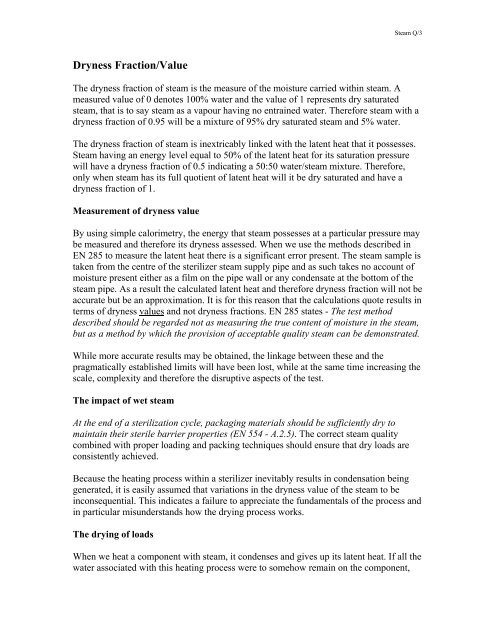THE APPLICATION OF STEAM QUALITY TEST LIMITS
THE APPLICATION OF STEAM QUALITY TEST LIMITS
THE APPLICATION OF STEAM QUALITY TEST LIMITS
Create successful ePaper yourself
Turn your PDF publications into a flip-book with our unique Google optimized e-Paper software.
Dryness Fraction/Value<br />
Steam Q/3<br />
The dryness fraction of steam is the measure of the moisture carried within steam. A<br />
measured value of 0 denotes 100% water and the value of 1 represents dry saturated<br />
steam, that is to say steam as a vapour having no entrained water. Therefore steam with a<br />
dryness fraction of 0.95 will be a mixture of 95% dry saturated steam and 5% water.<br />
The dryness fraction of steam is inextricably linked with the latent heat that it possesses.<br />
Steam having an energy level equal to 50% of the latent heat for its saturation pressure<br />
will have a dryness fraction of 0.5 indicating a 50:50 water/steam mixture. Therefore,<br />
only when steam has its full quotient of latent heat will it be dry saturated and have a<br />
dryness fraction of 1.<br />
Measurement of dryness value<br />
By using simple calorimetry, the energy that steam possesses at a particular pressure may<br />
be measured and therefore its dryness assessed. When we use the methods described in<br />
EN 285 to measure the latent heat there is a significant error present. The steam sample is<br />
taken from the centre of the sterilizer steam supply pipe and as such takes no account of<br />
moisture present either as a film on the pipe wall or any condensate at the bottom of the<br />
steam pipe. As a result the calculated latent heat and therefore dryness fraction will not be<br />
accurate but be an approximation. It is for this reason that the calculations quote results in<br />
terms of dryness values and not dryness fractions. EN 285 states - The test method<br />
described should be regarded not as measuring the true content of moisture in the steam,<br />
but as a method by which the provision of acceptable quality steam can be demonstrated.<br />
While more accurate results may be obtained, the linkage between these and the<br />
pragmatically established limits will have been lost, while at the same time increasing the<br />
scale, complexity and therefore the disruptive aspects of the test.<br />
The impact of wet steam<br />
At the end of a sterilization cycle, packaging materials should be sufficiently dry to<br />
maintain their sterile barrier properties (EN 554 - A.2.5). The correct steam quality<br />
combined with proper loading and packing techniques should ensure that dry loads are<br />
consistently achieved.<br />
Because the heating process within a sterilizer inevitably results in condensation being<br />
generated, it is easily assumed that variations in the dryness value of the steam to be<br />
inconsequential. This indicates a failure to appreciate the fundamentals of the process and<br />
in particular misunderstands how the drying process works.<br />
The drying of loads<br />
When we heat a component with steam, it condenses and gives up its latent heat. If all the<br />
water associated with this heating process were to somehow remain on the component,








